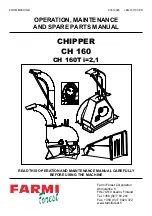
CTV-PRB004-EN
69
Starter Options
must be disabled or the sensitivity of all the starter trip levels must be readjusted so that theTrane
®
control panel acts as the primary protection for both the chiller and the starter.
Chillers used with non-Trane starters must ship with a special control panel to accommodate the
non-Trane starter. It is the responsibility of theTrane sales representative to select the “Starter by
Others (SBO)” option when pricing the chiller and to assure that the non-Trane starter is built
according to the proper “Starter by Others” specification.
Note:
The Enhanced Electrical Protection Package can simplify the procedure for using a non-
Trane starter; see
“
Implications of the Enhanced Electrical Protection Package and SMP option
on customer-supplied starters (SBO)
,” p. 67
.
In summary, when a customer wants to buy a starter from a manufacturer other than Eaton Cutler-
Hammer
®
, the procedure is as follows:
1.
Price the appropriate customer-supplied starter.
2. Provide a copy of the “Starter by Others” (SBO) specification S6516-0513 from CenTraVac Field
Sales Support to the customer/starter manufacturer. This specification lists the allowable
starter types.
3. Inform the customer that Trane assumes
no responsibility
for the design, construction,
compatibility, installation, startup, long-term support, and will not maintain records or
drawings for the resulting starter.
Power Factor and CenTraVac Chiller Motors
CenTraVac squirrel-cage induction motors normally have an uncorrected full-load power factor of
88 to 92 percent.The power factor decreases slowly as the motor’s torque output drops from full
load to approximately 50 percent, and then falls more rapidly at lower loads. If the full-load power
factor is corrected to 95 percent, the entire curve shifts upward and the corrected power factor
remains at a high value (
Figure 48, p. 70
).The current (amps) for a motor with a corrected power
factor is lower than the current for a motor with an uncorrected power factor.
In some cases, a power factor greater than 95 percent is specified for “all load ratios above
40 percent” or at a particular operating point. Multiple-capacitor arrangements with an elaborate
switching mechanism can provide this level of correction
without overcorrecting
by “cycling”
various capacitor combinations on and off as motor loading dictates; however, this arrangement
is complex and its cost may be prohibitive.
Typically, specifications stipulate a corrected power factor of 95 percent at full load.This results in
an economical application that balances the first cost of the capacitors with the benefits of a higher
power factor.
Several equations are helpful:
ApparentPower(kVA) =
ActualPower(kW)
=
Volts x Amps x
3
PowerFactor
1000
ActualPower(kW) =
Volts x Amps x
3 x PF
1000
CTV-PRB004.book Page 69 Sunday, December 18, 2011 6:39 PM














































